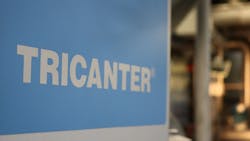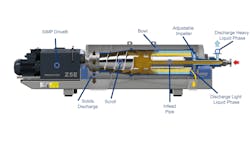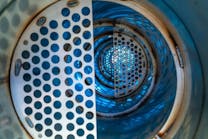Case study: Sophisticated separation for a fishmeal processing plant
Efficiently separating water, solids and oils has been a smooth process for nearly two decades at Ocean Protein, the only fishmeal processing plant in the state of Washington. The company transforms “trash to treasure” by using two easy-to-use Tricanters to take fish waste that would otherwise be discarded at sea or shipped out of the country and turn it into products that are used in aquaculture, livestock feed and pet food.
“One of the reasons we chose the Flottweg Z4E Tricanters over traditional decanters was because our product does not process well with a high-speed separator,” said Rick Crume, Ocean Protein’s plant manager. “We could accomplish everything we needed with less equipment this way. That was a big issue for us.”
A Tricanter separates three phases simultaneously, which traditionally requires a two-step process, using a decanter to separate water and oil from solids, then a separator to separate the water and oil.
The Tricanters were first installed in 2005, the year the facility was built in Hoquiam, Washington. The plant averages 4,000 MT of meal, 670 MT of oil and 80 MT of bone meal annually. A sister company to Ocean Gold Seafoods — which has the highest volume capacity for processing fish on the west coast — Ocean Protein pursues both technological and sustainable industry innovations.
The company recognizes that its efforts to achieve its goals of enhanced environmental sustainability, community development and local jobs has its challenges — chief among them being the challenge of containing and limiting odor, which is a natural byproduct of fishmeal processing. In its early days, the company struggled to make the industry’s then-current odor control standards fit the unique needs of a community where industrial and residential lines are so closely drawn. But in cooperation with regulatory agencies such as the Olympic Region Clean Air Agency (ORCAA) and the Department of Ecology (DOE), Ocean Protein has committed more than $5 million in advancing new odor control technologies.
That dedication led the DOE to state in a 2007 report that Ocean Protein was utilizing “the best available” technology for odor control. And the company continues to add more enhancements to its processes to ensure that the benefits it brings to the community are not outweighed by any negative repercussions of its processes.
The fishmeal separation process
Crume explained that fish remnants are essentially cooked — similar to how one might cook a roast. Just as a roast leaves “juices” in the pan, so too does fish in the cooking process. This “juice” is then processed to remove the oil from the liquid. The liquid is then processed to recover all the remaining proteins to produce the fish meal and fish soluble products.
“First, we cook the fish, then press it to get rid of some of the liquid and moisture,” Crume said. “The solid product goes to a dryer to be dried. Everything that is pressed off goes to the Flottweg Tricanter. That is the slurry with all the oil, water and solids. We use the Tricanter to separate the water, solids and oil. The solids go back to dryer with rest of solids. The water goes to an evaporator and the oil goes to a fish oil tank. We don’t have to polish anything. Right from that machine, the product goes directly to bulk sale.”
Ocean Protein installed the two Z4E Tricanters when the plant was built in 2005. The same machines continue to run efficiently with relatively low maintenance.
“We can only run at a certain gpm, so once we figured out our best configuration, we have now perfected the process and not had any problems,” Crume said. “The Tricanters are very low maintenance. We can do minor maintenance here at the plant, but when we need balancing or something more complicated, which is not very often, we ship the machines back to Flottweg and they send them back with a full inspection report, recommendations and pictures. It’s a very smooth process.”
How the technology works
In the classic separation process, solids are separated from a liquid, or two liquids of different densities are separated. But often both come together. The Tricanter allows the continuous separation of three phases (solid-liquid-liquid) in a single process. This is efficient in the treatment of oily sludges, in starch production and in fat recovery.
More than 40 years ago, Flottweg developed the Tricanter to separate three phases in a single simultaneous process. The prerequisites for this are that the liquids are not soluble in each other, that they have different densities and that the solids phase has the highest specific weight. On this basis, the specially designed impeller system produces optimal separation results.
Three-phase separation offers users several advantages. The combination of the processing steps eliminates the need for additional separation stages, which results in cost savings. In addition to its high selectivity, the Tricanter is particularly useful because of its versatility. It can adapt to changing feed conditions at any time.
The design and function of the Flottweg three-phase centrifuge is similar to that of a decanter (two-phase separation). Solids settle on the inner wall of the bowl when subjected to centrifugal force. The scroll constitutes the conveying tool.
The difference in the decanter lies in the discharge of two distinct liquid phases. With the Tricanter, the heavy liquid phase is discharged under pressure via an adjustable impeller and the light liquid phase via gravity. The impeller allows precise adjustment of the pond depth during operation and permits fast, precise adaptation to changing feed conditions — without interrupting operation.
The Tricanter is easy to operate and maintain due to its application-optimized, compact design. A motorized process is possible with impeller adjustment via an actuator controlled by the HMI.
During the feasibility stage, Flottweg uses its state-of-the-art laboratories to analyze a client’s sample material to determine the best machinery and process. Each separation system is customized to perform a specific separation task.
Results
Crume was aware of the efficiency and advantages of using a Tricanter from working with a different company before joining Ocean Protein at its inception.
“For me, choosing the Tricanter was a no-brainer,” Crume said. “We installed them at Ocean Protein and have never regretted it. Training for our operators was smooth and maintenance continues to be something we don’t have to worry too much about. Almost 20 years after installation, they are still working just as efficiently as they did back in 2005.”
Daniel Lakovic is the business development manager for Flottweg Separation Technology Inc. Lakovic holds a BS in International Business and an MBA in Finance. He can be reached at [email protected].



